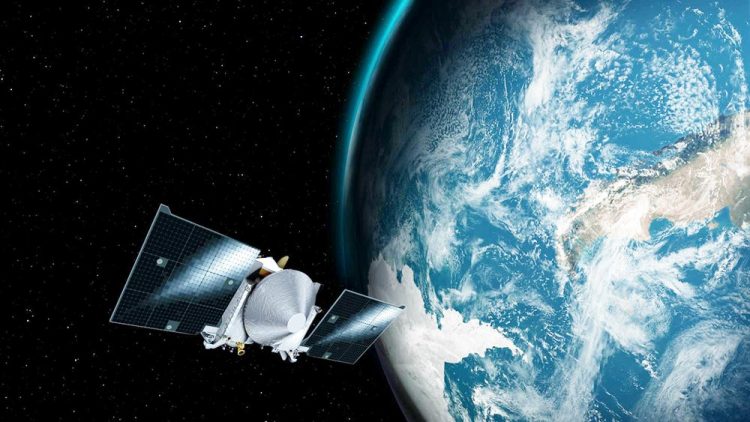NASA'S OSIRIS-REx spacecraft slingshots past Earth

This artist's concept shows the OSIRIS-REx spacecraft passing by Earth. Credit: NASA's Goddard Space Flight Center/University of Arizona.
At 12:52 p.m. EDT on Sept. 22, the OSIRIS-REx (Origins, Spectral Interpretation, Resource Identification, and Security – Regolith Explorer) spacecraft came within 10,711 miles (17,237 km) of Antarctica, just south of Cape Horn, Chile, before following a route north over the Pacific Ocean.
OSIRIS-REx launched from Cape Canaveral Air Force Station in Florida on Sept. 8, 2016, on an Atlas V 411 rocket. Although the rocket provided the spacecraft with the all the momentum required to propel it forward to Bennu, OSIRIS-REx needed an extra boost from the Earth's gravity to change its orbital plane. Bennu's orbit around the Sun is tilted six degrees from Earth's orbit, and this maneuver changed the spacecraft's direction to put it on the path toward Bennu.
As a result of the flyby, the velocity change to the spacecraft was 8,451 miles per hour (3.778 kilometers per second).
“The encounter with Earth is fundamental to our rendezvous with Bennu,” said Rich Burns, OSIRIS-REx project manager at NASA's Goddard Space Flight Center in Greenbelt, Maryland. “The total velocity change from Earth's gravity far exceeds the total fuel load of the OSIRIS-REx propulsion system, so we are really leveraging our Earth flyby to make a massive change to the OSIRIS-REx trajectory, specifically changing the tilt of the orbit to match Bennu.”
The mission team also is using OSIRIS-REx's Earth flyby as an opportunity to test and calibrate the spacecraft's instrument suite. Approximately four hours after the point of closest approach, and on three subsequent days over the next two weeks, the spacecraft's instruments will be turned on to scan Earth and the Moon. These data will be used to calibrate the spacecraft's science instruments in preparation for OSIRIS-REx's arrival at Bennu in late 2018.
“The opportunity to collect science data over the next two weeks provides the OSIRIS-REx mission team with an excellent opportunity to practice for operations at Bennu,” said Dante Lauretta, OSIRIS-REx principal investigator at the University of Arizona, Tucson. “During the Earth flyby, the science and operations teams are co-located, performing daily activities together as they will during the asteroid encounter.”
The OSIRIS-REx spacecraft is currently on a seven-year journey to rendezvous with, study, and return a sample of Bennu to Earth. This sample of a primitive asteroid will help scientists understand the formation of our solar system more than 4.5 billion years ago.
NASA's Goddard Space Flight Center provides overall mission management, systems engineering and the safety and mission assurance for OSIRIS-REx. Dante Lauretta of the University of Arizona, Tucson, is the principal investigator, and the University of Arizona also leads the science team and the mission's science observation planning and data processing. Lockheed Martin Space Systems in Denver built the spacecraft and is providing flight operations. Goddard and KinetX Aerospace are responsible for navigating the OSIRIS-REx spacecraft. OSIRIS-REx is the third mission in NASA's New Frontiers Program. NASA's Marshall Space Flight Center in Huntsville, Alabama, manages the agency's New Frontiers Program for the Science Mission Directorate in Washington.
Media Contact
All latest news from the category: Physics and Astronomy
This area deals with the fundamental laws and building blocks of nature and how they interact, the properties and the behavior of matter, and research into space and time and their structures.
innovations-report provides in-depth reports and articles on subjects such as astrophysics, laser technologies, nuclear, quantum, particle and solid-state physics, nanotechnologies, planetary research and findings (Mars, Venus) and developments related to the Hubble Telescope.
Newest articles

First-of-its-kind study uses remote sensing to monitor plastic debris in rivers and lakes
Remote sensing creates a cost-effective solution to monitoring plastic pollution. A first-of-its-kind study from researchers at the University of Minnesota Twin Cities shows how remote sensing can help monitor and…

Laser-based artificial neuron mimics nerve cell functions at lightning speed
With a processing speed a billion times faster than nature, chip-based laser neuron could help advance AI tasks such as pattern recognition and sequence prediction. Researchers have developed a laser-based…

Optimising the processing of plastic waste
Just one look in the yellow bin reveals a colourful jumble of different types of plastic. However, the purer and more uniform plastic waste is, the easier it is to…


